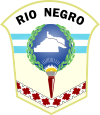Legislature of Río Negro
Legislature of Río Negro | |
|---|---|
 | |
| Type | |
| Type | |
| Leadership | |
President (Vice Governor) | Alejandro Palmieri (JSRN) since 10 December 2019 |
First Vice President | Julia Elena Fernández (JSRN) since 10 December 2019 |
Second Vice President | Humberto Alejandro Marinao (FDT) since 10 December 2019 |
| Structure | |
| Seats | 46 legislators |
 | |
Political groups | Government (28)
Opposition (18)
|
Length of term | 4 years |
| Authority | Constitution of Río Negro |
| Elections | |
| Parallel voting | |
Last election | 7 April 2019 |
Next election | 2023 |
| Website | |
| web | |
The Legislature of Río Negro Province (Spanish: Legislatura de la Provincia de Río Negro) is the unicameral legislative body of Río Negro Province, in Argentina. It convenes in the provincial capital, Viedma.
It comprises 46 legislators, 22 of whom are elected in a single province-wide multi-member district, while the remaining 24 are elected in eight three-member districts that divide the province's territory, called "electoral circuits" (circuitos electorales). Its powers and responsibilities are established in the provincial constitution.
Elections to the legislature take place every four years, when the entirety of its members are renewed. The legislature is presided by the Vice Governor of Río Negro, who is elected alongside the governor every four years.[1]
History
[edit]The Legislature was established in 1958, when the National Territory of Río Negro became a province of Argentina. The first legislature convened in the old building of the Teatro Argentino, in Viedma. In 1972, the military governor, Roberto Requeijo, ordered a series of renovations to better accommodate the legislature in the site of the Teatro Argentino.[2]
Electoral districts
[edit]Legislators in both the province-wide district and the eight electoral circuits are elected through proportional representation using party-list proportional representation, with D'Hondt system and a 5% electoral threshold. The electoral circuits do not correspond to the province's departments, but are rather divided using municipalities as its main criterion.[3]
The electoral circuits were first introduced ahead of the 1958 provincial elections, originally comprising six districts.[4] The current distribution was established in 2013, when the electoral law was last modified.[3]
| Electoral Circuit |
Municipalities | Map |
|---|---|---|
| Alto Valle Oeste | 
| |
| Alto Valle Centro | ||
| Alto Valle Este | ||
| Valle Medio |
| |
| Valle Inferior |
| |
| Andino |
| |
| Serrano/Línea Sur |
| |
| Atlántico |
|
References
[edit]- ^ "Río Negro". Observatorio Electoral Argentino CIPPEC (in Spanish). Retrieved 30 January 2022.
- ^ "Historia". Legislatura de la Provincia de Río Negro (in Spanish). Retrieved 30 January 2022.
- ^ a b "Elecciones Provinciales 2019" (PDF). Poder Judicial de Río Negro (in Spanish). Retrieved 30 January 2022.
- ^ Camino Vela, Francisco (May 2011). La dinámica política en la Provincia de Río Negro (Argentina) desde mediados del siglo XX: el predominio de la Unión Cívica Radical (PhD) (in Spanish). University of Seville. Retrieved 30 January 2022.
External links
[edit]- Official website (in Spanish)
- Constitution of Río Negro Province (in Spanish)
